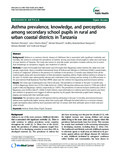Please use this identifier to cite or link to this item:
http://hdl.handle.net/10311/1267| Title: | Asthma prevalence, knowledge, and perceptions among secondary school pupils in rural and urban coastal districts in Tanzania |
| Authors: | Shimwela, Meshack Mwita, Julius C. Mwandri, Michael Rwegerera, Godfrey M. Mashalla, Yohana Mugusi, Ferdinand |
| Keywords: | Asthma, Rural, Urban, Pupils, Tanzania |
| Issue Date: | 2014 |
| Publisher: | Biomed Central, http://www.biomedcentral.com/bmcpublichealth |
| Citation: | Shimwela et al. (2014) Asthma prevalence, knowledge, andperceptions among secondary school pupils in rural and urban coastaldistricts in Tanzania. BMC Public Health, Vol. 14, pp387. |
| Abstract: | Background: Asthma is a common chronic disease of childhood that is associated with significant morbidity and mortality. We aimed to estimate the prevalence of asthma among secondary school pupils in urban and rural areas of coast districts of Tanzania. The study also aimed to describe pupils’ perception towards asthma, and to assess their knowledge on symptoms, triggers, and treatment of asthma. Methods: A total of 610 pupils from Ilala district and 619 pupils from Bagamoyo district formed the urban and rural groups, respectively. Using a modified International Study of Asthma and Allergies in Childhood (ISAAC) questionnaire, a history of “diagnosed” asthma or the presence of a wheeze in the previous 12 months was obtained from all the studied pupils, along with documentation of their perceptions regarding asthma. Pupils without asthma or wheeze in the prior 12 months were subsequently selected and underwent a free running exercise testing. A≥20% decrease in the post-exercise Peak Expiratory Flow Rate (PEFR) values was the criterion for diagnosing exercise-induced asthma. Results: The mean age of participants was 16.8 (±1.8) years. The prevalence of wheeze in the past 12 months was 12.1% in Bagamoyo district and 23.1% in Ilala district (p < 0.001). Self-reported asthma was found in 17.6% and 6.4% of pupils in Ilala and Bagamoyo districts, respectively (p < 0.001). The prevalence of exercise-induced asthma was 2.4% in Bagamoyo, and 26.3% in Ilala (P < 0.002). In both districts, most information on asthma came from parents, and there was variation in symptoms and triggers of asthma reported by the pupils. Non-asthmatic pupils feared sleeping, playing, and eating with their asthmatic peers. Conclusion: The prevalence rates of self-reported asthma, wheezing in the past 12 months, and exercise-induced asthma were significantly higher among urban than rural pupils. Although bronchial asthma is a common disease, pupils’ perceptions about asthma were associated with fear of contact with their asthmatic peers in both rural and urban schools. |
| URI: | http://hdl.handle.net/10311/1267 |
| ISSN: | 1471-2458 |
| Appears in Collections: | Research articles (Dept of Internal Medicine) |
Files in This Item:
| File | Description | Size | Format | |
|---|---|---|---|---|
| 1471-2458-14-387.pdf | 191.31 kB | Adobe PDF |  View/Open |
Items in DSpace are protected by copyright, with all rights reserved, unless otherwise indicated.
